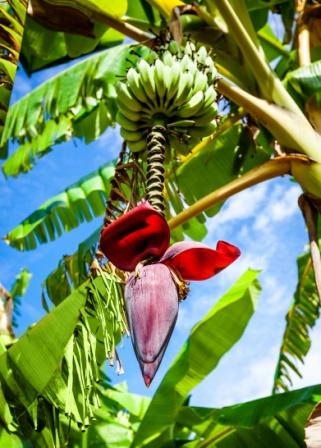Welcome to your holistic living

Botanical Name: Musa paradisiaca
Family: Musaceae
English Name: Banana tree, Plantain
Malayalam Name: Vaazha
Hindi Name: Kela, Amrit
The banana plant is the largest herbaceous flowering plant. All the above-ground parts of a banana plant grow from a structure usually called a “corm”. Plants are normally tall growing to a height of 1-4 m and are often mistaken for trees, but what appears to be a trunk is actually a “false stem” or pseudostem. The leaves of banana plants are composed of a “stalk” (petiole) and a blade (lamina). When a banana plant is mature, the corm stops producing new leaves and begins to form a flower spike or inflorescence. A stem develops which grows up inside the pseudostem, carrying the immature inflorescence until eventually it emerges at the top. Each pseudostem normally produces a single inflorescence, also known as the “banana heart”. The fruit is variable in size, color and firmness, but is usually elongated and curved, with soft flesh rich in starch covered with a rind which may be green, yellow, red, purple, or brown when ripe. The fruits grow in clusters hanging from the top of the plant. There are many varieties of banana and are found all over the Indian sub- continent in the temperate climate. Varieties of plantain and banana and their qualities: There are many sub varieties of plantain and Bananas. All in all, more sweet the fruit is, – more kapha increasing it is, – heavier to digest – more Pitta and Vata balancing – more unsuitable during cough, cold and asthma. – more suitable during gastritis, burning sensation, constipation, bloating. Part used- Fruit, Stem, Flower Dosage-Juice of stem- 10 to 20 ml; Ash of stem- 1-2 g Chemical composition of Musa paradisiaca: The ripened fruit of Banana contains about 22% sugar, starch, albuminoid, Vitamin C, B and A. An anti-ulcerogenic acylsteryl glycoside, sitoindoside IV, has been isolated from unripe banana. A pectin containing hexoses (32.4%) and uronic acid (52.5%) has been isolated from the pith of the stem.
Fruit, stem, flower
1. Blood Sugar Management: Musa paradisiaca has anti-diabetic potential, with studies suggesting it may help control blood sugar levels. 2. Digestive Health: Its soluble dietary fiber promotes regular bowel movements, and various parts are used to treat diarrhea and dysentery. 3. Anemia and Menstrual Health: The plant's B-vitamins support red blood cell production and help manage anemia and heavy menstrual bleeding. 4. Wound Healing: The extracts of the banana plant, particularly the peels, have shown potential in promoting wound healing. 5. Gastrointestinal Support: The plant is recognized for its therapeutic value in improving overall gastrointestinal health. 6. Antioxidant and Anti-inflammatory Effects: The extracts of the banana plant exhibit significant antioxidant and anti-inflammatory properties.
Antioxidant Anti-inflammatory Antimicrobial Antidiabetic properties Antimicrobial
Rasa: Madhura, Katu
Guna: Guru, Snigdha
Virya: Sita
Vipaka: Madhura
Dosha Karma: Vatapitta shamaka